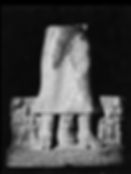Kushan Dreams
- sulla80
- Aug 21
- 4 min read
Updated: Aug 23
For many years I have admired the gold coins of the Kushan kings and finally decided it was time to move from admiring to owning. This coin is certain to be near the top of my top 10 list this year.

INDIA. Kushan Empire. Vasudeva I (ca. AD 190-230). AV dinar (20mm, 8.02 gm, 1h). Choice VF. Kushan standard, Bactria, main mint (probably Balkh), middle phase.
Obv: Þ-AONANOÞAO BA-ZOΔHO KOÞANO, Vasudeva I standing facing, nimbate head left, wearing jewel-edged triangular helmet with forehead ornament, circular side ornament and jeweled earflap, diadem with tie and long ribbons to right, clad in full armor, long-sleeved knee-length tunic with heavy segmented collar and neck guard, banner behind head attached to back, coils covering arms, tunic of plate mail, worn over trousers and high boots, flames emanating from right shoulder, grounded filleted spear in left hand, dropping pellets from right hand over lit altar at left, sword at hip held by belt; filleted trident at left, dotted line beneath feet
Rev: OHÞO, Oesho (Siva or Shiva) standing facing, with one head, hair in topknot with curls outlining face, curls and eyes shown as dots, two arms, erect lingamm, wearing ankle-length dhoti with symmetrical folds, grounded trident in left hand, diadem with two ribbons in right; the bull Nandi standing left behind, tamgha to upper left, dotted border.
Ref: ANS Kushan 1086-1090. Mitchiner -. Sunrise 551. Göbl, MK 509.
Vasudeva I (c. AD 191–232), the last of the "Great Kushans", succeeded Huvishka and presided over a still‑wealthy but contracting empire stretching from Bactria to the Gangetic plain. His dated inscriptions run from year 64 to 98 of the Kanishka era and anchor his reign. His coinage was struck in Bactria and northwestern India with a standardized a royal image of the king sacrificing at an altar and a Kushan divine repertoire that was almost exclusively reduced to Oēsho (Śiva). Oesho/Śiva on coins bridges Iranian and Indian traditions.
Obverse legend (Bactrian in Greek script): ϷΑΟΝΑΝΟϷΑΟ ΒΑΖΟΔΗΟ ΚΟϷΑΝΟ → Shaonanoshao Bazodeo Koshano = “King of kings, Vasudeva the Kushan.” This formula and its script are standard for late Great Kushan gold.
Reverse legend: ΟΗϷΟ (Oēsho), the Kushan rendering of Śiva, here with trident and bull Nandi.
What is the imagery (and why it matters)?
Obverse: the king, nimbate, flaming, sacrificing over a fire altar. Vasudeva stands armored, with a nimbus and a flame issuing from the shoulder—an icon of royal glory adapted in Kushan art and pours pellets as a libation over a small fire altar. Scholarly treatments trace this standing‑king‑at‑altar type to Arsacid/Irano‑Central Asian court imagery, refitted for Kushan kingship. The added filleted trident on the obverse ties the royal act explicitly to Śaiva cult.
Reverse: Oēsho (Śiva) with Nandi and lingam. Vasudeva’s coinage sharply shrinks the earlier pantheon (so prominent under Kanishka and Huvishka) to almost only Oēsho/Śiva - a deliberate statement of religious alignment with Śaiva worship current in the northwestern subcontinent. The trident, diadem, erect liṅga, and Nandi render a recognizably Indian icon within Bactrian‑script labels, emblematic of the Kushans’ bicultural vocabulary.
Language and authority.
Legends are written in Bactrian using the Greek alphabet, a hallmark of Kushan statecraft (the only Middle Iranian language to do so). Styling himself “King of Kings” in that register while showing Śiva in Indian iconography visually fuses Iranian‑Central Asian sovereignty with Indian religious legitimacy.

Historical placement.
A Bactrian/Balkh issue of the middle phase implies control over Bactria before the Sasanian push that, by the 230s–240s, created the Kushano‑Sasanian overlordship in the Oxus region. This coin type and mint point to Vasudeva’s last moment of true trans‑Oxus authority.
Where is Balkh?

Vasudeva I (Bactrian Bazodeo) ruled circa AD 191–232, succeeding Huvishka and ending the classic Kushan sequence. Inscriptions dated KE 64–98 (≈ AD 191–232) frame his tenure.
Vasudeva I governed during a moment when Kushan power refocused from Bactria toward Mathurā (a city/regon in northern India), diplomacy with China continued even as Sasanian pressure mounted on the northwest, and state ideology visibly shifted - on coins and in sculpture - toward Indian forms, especially Śaivite (related to Shiva) imagery, while continuing to support Buddhism.
Founded in 224 CE, the Sasanian state moved into former Kushan lands in Bactria and Gandhāra; by the mid‑3rd century these regions were governed by Kushanshahs within a Sasanian framework (the “Kushano‑Sasanian” realm). This strategic squeeze framed the late Vasudevan and immediate post‑Vasudevan decades.
Politically he maintained the core Punjab-Gandhāra heartland and, through much of his reign, Bactria, while a strengthening Sasanian monarchy began pressing from the west. Numismatically, he regularized a standing king making a fire‑altar offering and a Śaiva reverse, striking in gold and base metal from Balkh and northwestern Indian mints; the narrowed pantheon and Śaiva emphasis are the signature of his rule. Following Vasudeva, power bifurcated: western domains fell under Kushano‑Sasanian control, while eastern Kushan rulers continued chiefly around Mathurā.

The gold dinat of Vasudeva claims, in Bactrian‑script, Kushan universal kingship paired with Śiva as the state cult, struck on a Silk‑Road gold standard that still moved wealth across Iran, Central Asia, and India on the eve of Sasanian realignment.
References:
F. Sinisi, “Royal Imagery on Kushan Coins: Local Tradition and Arsacid Influences”, JESHO 60 (2017)
